6172RB Science a STEM approach Year 2 low res watermark
You also want an ePaper? Increase the reach of your titles
YUMPU automatically turns print PDFs into web optimized ePapers that Google loves.
Biological sciences<br />
GROWING AND CHANGING<br />
<strong>STEM</strong> project<br />
Teacher notes<br />
<strong>STEM</strong> project:<br />
Design and create a mat for a Bee-Bot activity, which shows how a living thing grows and changes.<br />
Students can then program a Bee-Bot to move along the correct pathway. (If your school does not<br />
have access to Bee-Bots, students act as a ‘Bee-Bot’ and move around the mat as directed by a<br />
fel<strong>low</strong> student.)<br />
Estimated duration: 4 weeks<br />
1. Introduce the project<br />
• Go to and<br />
ask students what they know about Beebots<br />
or other robots. How do they move?<br />
What kind of instructions do they need?<br />
Note: The direction pad shows forward and<br />
backward using up and down arrows, and<br />
turns using left and right arrows.<br />
• Watch the video about how a Bee-Bot<br />
works at .<br />
• Display page 32 to read to the class and<br />
introduce the problem and task—to design<br />
and create a Bee-Bot mat and program a<br />
Bee-Bot to fol<strong>low</strong> the life cycle of a living<br />
thing in the correct order. Clarify what a<br />
living thing is, and any details about the<br />
task that students do not understand. Give<br />
students a copy of the project steps on<br />
page 33.<br />
2. Investigate<br />
• Students select a living thing and explore<br />
how it grows and changes throughout its life.<br />
Students use page 34 to collate information.<br />
Information from previous lessons can be<br />
applied here. If more stages are needed,<br />
students can draw up their own table.<br />
• Students explore the website individually to<br />
ensure they understand how a Bee-Bot<br />
moves and what type of instructions are<br />
required to program it.<br />
• Students explore the website to explore different<br />
mats that can be used with a Bee-Bot.<br />
Display the example on page 35.<br />
• Practise how to instruct a Bee-Bot/student<br />
to the different stages in the life of a<br />
butterfly in the correct order, using page 35.<br />
3. Design, plan and manage<br />
• Students design a mat by sketching a plan<br />
first, using page 36. The sketch should<br />
include images of stages of the living thing<br />
as it grows and some extra decorative<br />
squa<strong>res</strong> to complete the 4 x 4 configuration.<br />
Students may write details about the<br />
changes in the living thing at each stage if<br />
space al<strong>low</strong>s.<br />
4. Create<br />
• Groups create their design cooperatively<br />
and decide who will complete each<br />
component of the design.<br />
• Students measure and rule up the squa<strong>res</strong><br />
on the mat using a large sheet of cardboard<br />
or a piece of white vinyl cut to the length and<br />
width of two rulers; i.e. 60 cm x 60 cm. Divide<br />
the large squa<strong>res</strong> into sixteen equal-sized<br />
squa<strong>res</strong> in a 4 x 4 array.<br />
• Students draw and label images of different<br />
stages in the life cycle of a living thing on the<br />
squa<strong>res</strong>. Other images/text relating to the<br />
living thing such as elements of its habitat<br />
will also need to be drawn as filler squa<strong>res</strong>.<br />
Alternatively, students may repeat some of<br />
the stages so a number of different pathways<br />
can be programmed into the Bee-Bot.<br />
• Students write one way of programming the<br />
Bee-Bot so it fol<strong>low</strong>s the growth of the living<br />
thing in the correct order.<br />
5. Evaluate and refine<br />
• Students check that their mat includes all<br />
stages of how the living thing grows and<br />
changes throughout its life.<br />
• Students also check that their mat is<br />
constructed correctly and contains<br />
16 equal-sized squa<strong>res</strong> in the correct array.<br />
6. Communicate<br />
• Students display their mat, explaining<br />
how they made it and describing the life<br />
cycles of their chosen living thing. They can<br />
demonstrate the programming they worked<br />
out to navigate to the stages of the life<br />
cycle. Once they know the life cycle, other<br />
students should be given opportunities to<br />
test the Bee-Bot mats of other students.<br />
Discuss the directions in terms of turns and<br />
position, as well as simple digital code.<br />
© R.I.C. Publications<br />
Low <strong>res</strong>olution display copy<br />
R.I.C. Publications® – www.ricpublications.com.au 978-1-925431-95-7 YEAR<br />
<strong>Science</strong>:<br />
A <strong>STEM</strong> APPROACH<br />
31<br />
2


















